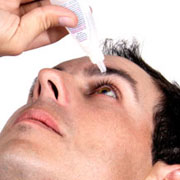 The eye bathes itself in tears to stay moist. Some people don’t produce enough tears for healthy eyes. This is called dry eye. Moist eyes are essential to comfort and health. Also, dry eyes may mean other problems.
The eye bathes itself in tears to stay moist. Some people don’t produce enough tears for healthy eyes. This is called dry eye. Moist eyes are essential to comfort and health. Also, dry eyes may mean other problems.
What are the risk factors for dry eye?
Tear production normally decreases as we age. Although dry eye can occur in both men and women at any age, women are most often affected. This is especially true after menopause.
Other risk factors include:
- Smoking
- Eye surgery (such as LASIK or for cataracts)
- Exposure to environmental irritants (e.g., prolonged exposure to wind, sleeping with a fan on at night, low humidity, frequent air travel)
- Ocular surface diseases
A wide variety of common medications – both prescription and over-the-counter – can also cause dry eye by reducing tear secretion. Be sure to tell your ophthalmologist, Eye M.D., the names of all the medications you are taking, especially if you are using diuretics, beta-blockers, antihistamines, sleeping pills, medications for “nerves,” or pain relievers.
People with dry eye are often more prone to the toxic side effects of eye medications, including artificial tears. These people may need special preservative-free artificial tears.
Symptoms & Diagnosis
The usual symptoms of dry eye include:
- stinging
- burning
- scratchiness
- stringy mucus
- excessive irritation from smoke and wind
- discomfort when wearing contact lenses
- watering eyes
Watering eyes from dry eye may sound illogical, but tears are also the eye’s response to discomfort. If the tears responsible for maintaining lubrication do not keep the eye wet enough, the eye becomes irritated. Eye irritation prompts the gland that makes tears to release a large volume of tears, overwhelming the tear drainage system. These excess tears then overflow from your eye.
An Eye M.D. is usually able to diagnose dry eye by examining the eyes. Sometimes tests that measure tear production are necessary. The Schirmer tear test involves placing filter-paper strips under the lower eyelids to measure the rate of tear production under various conditions. Another test uses a diagnostic drop to look for certain patterns of dryness on the surface of the eye.
Tear production normally decreases as we age. Although dry eye can occur in both men and women at any age, women are most often affected. This is especially true after menopause.
Last reviewed and updated in February 2009,
by the American Academy of Ophthalmology.

